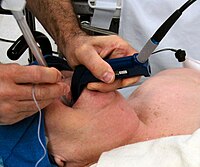
Photo from wikipedia
PURPOSE To propose the Dysphonia Risk Screening Protocol for Musical Theatre Actors (DRSP-MTA), to verify its applicability in association with the General Dysphonia Risk Screening Protocol (G-DRSP), to correlate the… Click to show full abstract
PURPOSE To propose the Dysphonia Risk Screening Protocol for Musical Theatre Actors (DRSP-MTA), to verify its applicability in association with the General Dysphonia Risk Screening Protocol (G-DRSP), to correlate the final scores of both, and these with the total risk score, and to compare the risk of dysphonia measured in musical theater actors with and without vocal complaint. METHODS An observational cross-sectional study with 34 musical theater actors, adults, of both genders, with and without vocal complaints and regardless of whether they are professionals or students. The questionnaires were applied individually. Statistical analysis made it possible to verify the correlation between the dysphonia risk scores and to compare the groups with and without vocal complaint. RESULTS Most of the participants were male, young adults, professional actors and without vocal complaint. There was a high risk of dysphonia, evidenced by the application of G-DRSP, with means scores compatible with values found in individuals with dysphonia, and reinforced by the indices found with DRSP-MTA application. There was a moderate and directly proportional correlation between the two questionnaire scores; and a correlation of both with the total risk score. Higher G-DRSP scores were observed in the vocal complaint group. CONCLUSION DRSP-MTA was feasible and easy to apply and was positively correlated with the total score and G-DRSP score. A high risk of dysphonia was evidenced in individuals with vocal complaints. Although the specific DRSP-MTA score did not differentiate musical theatre actors with and without vocal complaints, the G-DRSP score and the total risk score performed such differentiation.
Journal Title: CoDAS
Year Published: 2021
Link to full text (if available)
Share on Social Media: Sign Up to like & get
recommendations!